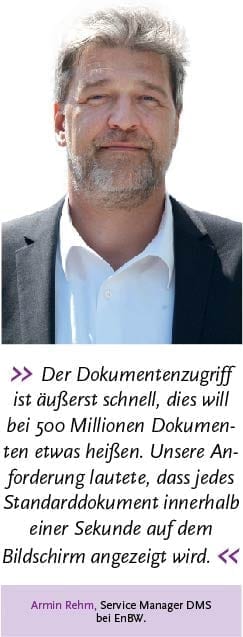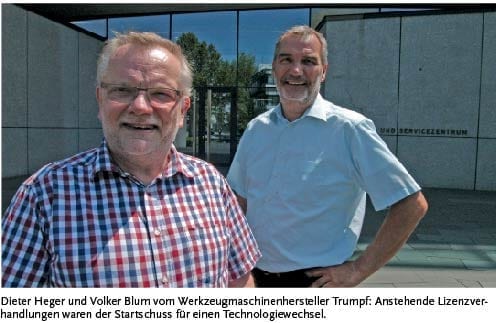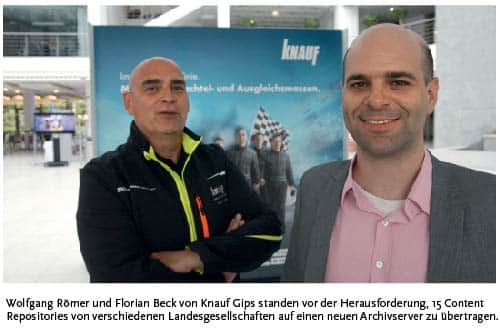Archive instead of passive
![[shutterstock.com:246719938, Sashkin]](https://e3mag.com/wp-content/uploads/2016/09/Archiv.jpg)

Each scenario has its own character - whether at the industrial yarn manufacturer Coats, at EnBW, at the machine tool manufacturer Trumpf or at Knauf Gips.
What they all have in common is the enormous savings potential that results from cloud-based SAP archiving, the integration of CAD data or the management of particularly large data volumes.
Complete Private Cloud: Coats Industrial Yarns
SAP is the main ERP system at the industrial yarn manufacturer Coats, with 2800 users worldwide. As far as archiving in the ERP environment is concerned, Coats had been using another vendor's solution for years.
Changing license models, complicated updates and the need to maintain additional database servers for the archive led users and the Global Technology Team in particular to consider an alternative.
 They wanted to replace the old, proprietary DMS with a fast, low-maintenance solution and implement a lean way of archiving SAP in the cloud overall.
They wanted to replace the old, proprietary DMS with a fast, low-maintenance solution and implement a lean way of archiving SAP in the cloud overall.
KGS found the right concept for these requirements. The KGS ContentServer4Storage was introduced in the fall of 2015. KGS undertook the migration from the old to the new archive, which took just under three months, by using Migration4ArchiveLink, the software for the simple and controlled execution of archive migrations in the SAP environment. 8.6 million documents - orders, production orders, material documents, etc. - with around six terabytes had to be transferred.
At the beginning of 2016, the SAP system for North America was completely connected to KGS ContentServer4Storage, and by mid-March 2016, the other SAP systems had also been migrated.
"We were impressed by the speed and by how straightforward the archive changeover was during ongoing operations."
said Hagen Hoss, Platforms and Storage Solutions Architect in Coats' Global Technology Team.
As far as the overall architectural concept of the integrated ERP archive landscape is concerned, Coats occupies a technical pioneering position among companies of its size worldwide.
Because on premise has long been a discontinued model at the industrial yarn manufacturer: Not only the worldwide SAP systems - in addition to the USA, there is one each for Europe, East Asia and Southeast Asia - are hosted entirely in the private cloud at a data center operator in Vienna.
Coats has also moved its KGS archive landscape completely to the cloud; the servers are located in the Microsoft Azure Cloud in Ireland and store the data in the Azure file system. An express connection with 500 mbit transfer speed ensures that there are no performance problems. Consequently, the migration of the data did not take place at Coats, but the KGS Migration Server was installed in Azure and connected to the legacy archive.
"We just defined which content repositories needed to be migrated, and KGS Migration4ArchiveLink then performed the migration flawlessly"
Hagen Hoss explains.
Going to the cloud is purely a question of cost for the industrial yarn manufacturer, because rented servers are significantly cheaper than purchased ones. It is currently being examined where this can be realized, because in some countries it is a legal requirement to store business data within the country's borders. Here, the addition of KGS archive servers installed on premise would then be the solution.
Hagen Hoss:
"In close cooperation with Microsoft and SAP, we are currently preparing the switch of our SAP suite to Azure as well. In the medium term, we will then also migrate to S/4 Hana."
S/4 Hana in the cloud with integrated archive functionality - this would probably make Coats one of the first to implement such a forward-looking architecture.
 Document management with high speed at EnBW
Document management with high speed at EnBW
In a company of the size of energy provider EnBW, it is inevitable that documents are created from numerous systems: initially from the various modules of the ERP system as well as from various non-SAP systems. In addition, there is a file-oriented document storage system in SAP Folders Management as well as a document management system and a SharePoint environment.
With KGS solutions, EnBW created a completely new and global archive architecture for these document sources. The archive project is particularly impressive due to its sheer volume of data.
The energy provider manages around half a billion documents, corresponding to a total size of 50 terabytes. From around 500 million documents stored in several different systems, the right document has to appear on a customer advisor's screen within a second at the click of a mouse.
This can only be achieved with a high-performance archive. When it was newly implemented, the system accessed previous hierarchical storage systems. This enabled EnBW to retain the underlying SAM-FS file system, which at the time comprised around ten terabytes, with connected storage systems for the long-term archive.
The archive migration took place purely at database level. The archive was initially used for document storage in the inventory system, i.e., for the individual SAP modules ISU, CRM, PM, etc. The various business units have also set up separate file solutions for personnel, brands, construction in SAP Folders Management, which also use the new software as an archive component.
In addition, there is the large area of non-SAP applications such as sales systems. To enable third-party systems to operate the software via ArchiveLink, the IT department has programmed its own middleware, the so-called Document Management Center (DMC).
"We are thus opening the archive to any input channels".
justifies Torsten Zytowski from the IT Functional Units and Generation department.
"There is no longer hard wiring from the archive to a specific application like SAP, but the product can be used as an archive for all leading systems that a company sets up once over time"
Zytowski continues.
Normal office scanners are also connected to the archive via the DMC. Documents can thus be digitized and stored directly in the daily work process.
Of the approximately 20,000 employees at EnBW, more than 8,000 regularly work at a computer screen and thus deal with digital documents on a daily basis. It is therefore important that the underlying archiving system reliably and quickly provides the requested documents.
"The requirement from our internal departments was that a customer service representative on the front end taking calls would have any standard document on the screen within a second. We are achieving the target today"
explains Torsten Zytowski. EnBW has already received several awards for this achievement.
Trump: Worldwide access to CAD documents
A special feature of the KGS project at machine tool manufacturer Trumpf is the archiving of globally distributed CAD documents, for which KGS designed a new cache server concept.
"When we were once again faced with licensing negotiations with our archive provider, it was clear to us that the time was ripe for a technology change."
says Volker Blum, Head of Basis Support SAP Systems at Trumpf.
According to the previous licensing policy, each SAP user corresponded to one archive user - an expensive matter with 7,000 ERP users. In general, Trumpf does not need a fully comprehensive ECM solution where every new functionality, such as e-mail archiving, has to be installed at great expense, says Blum.
Instead of a powerful collaboration ECM suite for all needs, Trumpf relies on KGS, a lean solution based on an SAP-centric approach that exclusively handles document storage in conjunction with SAP.
For Trumpf, CAD design and CAD data management play a central role. Trumpf manages the assemblies of the machines, some of which can consist of more than 10,000 individual parts, in SAP PLM.
These documents must be stored and made available in a timely manner to the design departments located in 15 countries around the world. A major challenge given the typically very large files in this environment.
To do this, Trumpf used the old DMS to build a complex and performance-critical infrastructure with content (archive) and cache servers.
Dieter Heger, IT administrator of SAP Basis Support at Trumpf:
"If we were to store all CAD data centrally in Ditzingen, our globally distributed design engineers in China, for example, would always have to load the CAD data completely from Ditzingen via the WAN and save it back again when they want to continue working on an assembly. This would make it impossible to work smoothly.
The complex infrastructure of content and cache servers, which has grown over the years and communicates with each other and with SAP PLM, was therefore replicated by Trumpf at its global design sites in close cooperation with KGS.
Replacing the content and cache servers, and thus the complete archive infrastructure at all design sites, was a challenging task on its own, preceding the actual data migration.
Because the cache servers of the predecessor system cannot communicate one hundred percent with the KGS ContentServers, it was not possible to switch over location by location. Instead, all cache servers had to be replaced sequentially before the KGS ContentServers.
Trumpf worked with both new KGS cache and legacy content servers for a transition period.
"Apart from KGS, we found no manufacturer who was able to implement our special requirements within this unique construct in their solution and who immediately understood what we were about. Because our cache server-based infrastructure goes far beyond the standard functionality of SAP archiving with ArchiveLink."
says Dieter Heger.
Each location worldwide now has its own KGS ContentServer4Storage, which locally stores the parts for which the location is responsible. For the standard parts located in Ditzingen, local KGS CacheServers have been set up in parallel in each case to provide such remote parts locally.
If the designers want to load an assembly, they log on to SAP PLM and specify the assembly. SAP then resolves the BOM and the local parts are loaded from the KGS ContentServer4Storage on site, the standard parts from the KGS CacheServer on site.
With this architecture, Trumpf has immense performance advantages over a central solution. SAP knows each individual server, monitors which one is failing, and can switch to alternative servers.
The SAP system also knows exactly to which location a particular workstation/PC belongs and whether access is local or remote. After replacing all the servers, Trumpf began the actual migration of a total of around twelve terabytes of data from the old to the new system in summer 2016.
The KGS Migration4Archivelink solution was used for this purpose. The users were completely unaware of this migration running in the background. A total of approximately 68 million commercial documents and around seven million CAD files were migrated. The savings in maintenance costs amount to approximately 66 percent.
Knauf: Save on maintenance, servers and licenses
Knauf Gips is another long-standing SAP user that has closely integrated its archive landscape with SAP as the leading system and uses KGS solutions for this purpose.
The main driver for the introduction of the new archive was initially to reduce the costs for maintenance and operation. Another reason was to redesign the archive landscape.
"We had 15 content repositories for the different country organizations"
explains Florian Beck, responsible for workflow and SAP archiving at Knauf.
"Different databases were therefore also necessary in the DMS system. In SAP, we always had to ensure that archiving was done to the right repositories in each case and that they didn't get too big either."
After the decision for KGS at the beginning of 2015, the migration took place in the same year. All 15 previous content repositories, which are connected to various SAP systems, with a volume of between 50 and 60 million documents and almost six terabytes, were transferred smoothly from the old to the new archive servers by the migration software KGS Migration4ArchiveLink in just a few weeks. An auditor previously gave his stamp of approval for the archive switch.
Knauf has 70 KGS ScanClients in use internationally for recording documents, 25 of them in Germany. Selected departments also have simple scanners with ScanClients on which colleagues can digitize incoming documents and assign them to SAP documents.
In the future, all scanning tasks are to be consolidated in the respective central mailrooms. No one will have to go on site to administer the internationally deployed ScanClients or to set them up at workstations.
KGS has developed an administration solution for this in the form of the KGS Scan Server. This gives Florian Beck and his colleagues an overview of which PC in which country is using the KGS ScanClient.
They can distribute the software from Iphofen and manage the respective profiles centrally. What Knauf saves in the area of archiving can already be calculated in the first year of the switch - in which the complete previous service effort for the legacy system and its client was eliminated.
Via a KGS company license, every SAP workstation is automatically an archive workstation. This also eliminates the need for re-licensing, which was common in the past. The solution has therefore paid for itself within two years.







